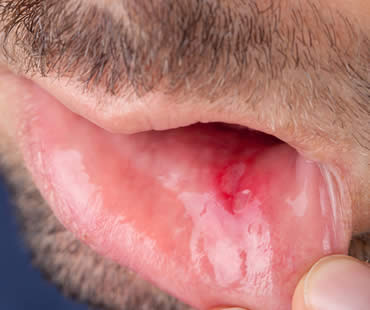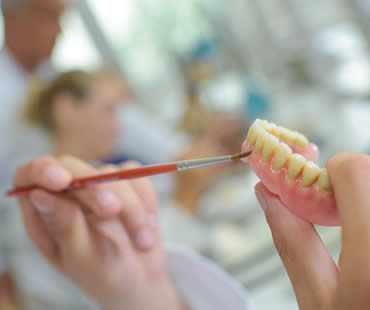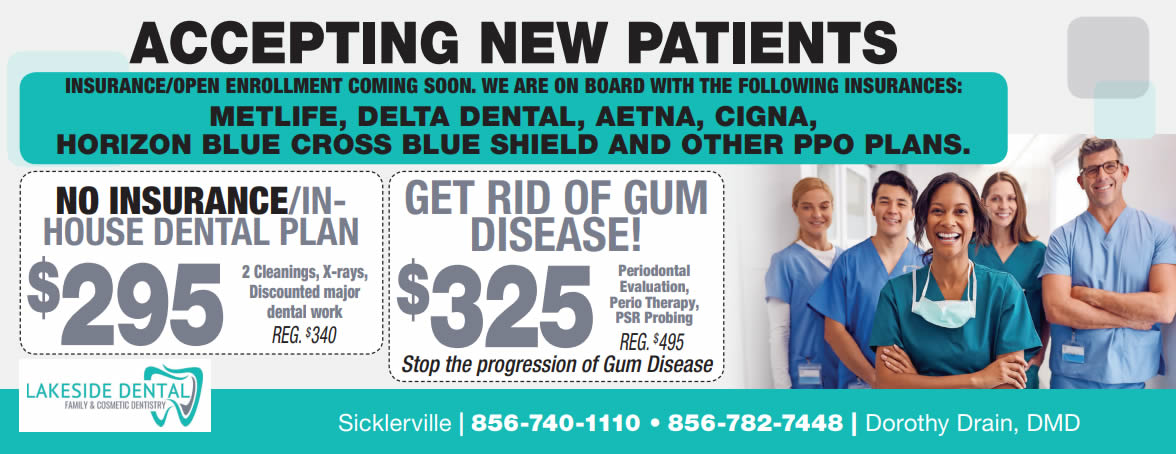
Sores in or around your mouth are painful and unsightly. They can have a variety of causes, such as infections, irritation from orthodontics or dentures, and symptoms of another health problem. Here are descriptions of the most common mouth sores.
Cold sores
Also called fever blisters, cold sores appear around your lips, nose, or chin. These extremely contagious, fluid-filled blisters are caused by the herpes simplex virus type 1. Once you are infected with primary herpes, the virus remains in your body and occasionally flares up. Cold sores typically heal by themselves in about a week. Over-the-counter topical anesthetics may help, and your dentist may prescribe antiviral medications to reduce occurrences.
Canker sores
These small ulcers only appear inside your mouth. They are white or gray with a red border, and are not contagious. Experts are unsure of the exact cause, but suspect they are related to immune system deficiencies, viruses, or bacteria. Canker sores usually heal on their own in a week or two. It is advised to avoid spicy, hot, or acidic foods that can irritate the sore. Over-the-counter mouthwashes or topical anesthetics may help, and your dentist may prescribe antibiotics if a secondary infection occurs.
Thrush
Oral thrush, or candidiasis, is a fungal infection occurring when the yeast Candida albicans reproduces in great amounts. Common with denture wearers, it most often appears in people with weakened immune systems such as the elderly or ill. People with dry mouth or who are on antibiotics are also at greater risk for thrush. The key to controlling candidiasis is treating the condition that causes it. Dentures should be cleaned regularly and removed at bedtime, and dry mouth should be treated in an effort to lessen that condition.
Leukoplakia
Leukoplakia are thick, white patches that grow on the inside of your cheeks, gums or tongue. Common with tobacco users, they result from irritations from habits like chewing on your cheek or wearing ill-fitting dentures. Leukoplakia are also associated with oral cancer. Treatment focuses on addressing the reasons for the lesion, such as quitting smoking or replacing dentures.
If you live in the Sicklerville area contact us today

Many patients seeking the stability and durability of dental implants wonder what the difference is between mini implants or standard sized dental implants. The basic differences are with regard to their intended function.
A standard dental implant is larger than 3 millimeters in diameter and is made up of two parts: the screw and the abutment. The screw portion of a dental implant is made of titanium, a non-toxic metal well tolerated by the body. The success of all dental implants is due to this bio-compatibility. Materials that aren’t tolerated by the body can create a response by the immune system and may lead to serious problems over time.
With a standard implant, the screw has two threaded areas: external, to screw into the bone and internal, to accommodate any components that are screwed into the implant for security. This internal area provides for the abutment. It is on this abutment that the tooth portion of a dental implant is attached. It also holds dentures firmly in place.
A mini dental implant is smaller than 3 millimeters in diameter and has one solid piece instead of screw and abutment. A mini implant has a solid screw body with a rounded ball shape that extends out of the jawbone. This rounded ball can hold a denture with a corresponding slot, keeping the restoration firmly in place.
Because they are smaller, mini implants provide less support than a standard implant. For example, four mini implants would be needed to hold a patient’s lower dentures in place securely. For the same job, only two standard sized implants would suffice.
Consult your dentist to determine if mini implants or standard implants are right to address your missing tooth or teeth. Get the right implant for your specific needs.
If you need a dentist in Sicklerville contact us today

Everyone wants to have a whiter, healthy smile. Home teeth whitening has become an extremely popular means to achieve those pearlier whites in the past couple of decades. In many cases, over-the-counter whitening kits are effective and safe. However, there are some disadvantages and risks to using over-the-counter home whitening kits:
- Off-brand whitening kits often contain dangerous concentrations of bleach or peroxide. This can cause erosion of the tooth enamel, and irritation to the sensitive gums and soft tissues of the mouth.
- Because many kits contain trays that do not adhere properly to your teeth, gums can become irritated and chemicals can leak out and be ingested causing stomach problems.
- Poorly fitted trays and varying concentrations of chemicals from lower quality kits may also result in unwanted discoloration of teeth or uneven results.
- Exposure to excessively harsh chemicals in off-brand kits can also cause gum shrinkage and oral infections.
When considering at-home whitening, it is best to stick to name brand kits to ensure the quality and safety of the treatment. Many popular brands of kits are both safe and efficient when used as directed. In any case, you should not consider at-home whitening if any of the following apply:
- You have deep, untreated cavities.
- You are pregnant.
- You suffer from gum disease.
The safest and most effective method for whitening your teeth is to have treatment by a dental professional, either in-office or with professional take-home trays. A qualified dentist can whiten your teeth up to ten shades in as little as one office visit. Consult with your dentist before pursuing any type of whitening treatment to ensure you will achieve the whiter smile you desire in the safest and quickest manner possible.
Our dental office is located in Sicklerville

Thanks to advances in dental technology, dentures are more natural looking and comfortable than ever before. If you are one of the many adults wearing dentures to replace missing teeth, there are several do’s and don’ts you will want to follow to ensure they maintain their fit and your oral health:
- Do take your dentures out before going to bed, allowing your mouth tissues to rest from wearing them all day.
- Don’t let your dentures dry out. Soak them in mild denture solution or water while you sleep.
- Do clean them daily with either a mild detergent or special denture cleaning solution and a soft-bristled brush.
- Don’t soak them in very hot water, as this could cause them to warp, and they will no longer fit properly.
- Do handle them with care. Dropping your dentures or treating them with strong cleansers or harsh brushes can do permanent damage.
- Don’t neglect your oral care for the rest of your mouth. Even patients with a full set of dentures need to take care of their gums, and if you have partial dentures you should continue to brush and floss your remaining teeth regularly.
- Do pay attention to changes in the fit or feel of your dentures. Problems with fit can lead to irritation and discomfort, and could also be an indication of gum disease.
- Don’t try to adjust or repair your dentures on your own. If your dentures are ill-fitting or damaged in any way, schedule an appointment with your dentist to have them evaluated.
- Do continue to see your dentist for regular checkups to help maintain your best oral health and check your dentures for fit and function.
If you are missing all or some of your teeth, dentures can greatly improve both your appearance and the quality of your life. By following these simple guidelines, you can maintain the beauty and functionality of your dentures for many years.
We look forward to seeing you in our Sicklerville dental office

Does your smile need some work? Are you sensitive about your teeth and how you may look while you eat or drink? Does speaking in public leave you anxious because you’re worried about the appearance of your teeth? Have you been putting off talking to a cosmetic dentist because you’re worried about the dental therapies you might need? Don’t be afraid of a smile makeover! A smile makeover can be a simple thing, as minor and fast as teeth whitening, a process that can often be completed in-office in a single visit.
If you are looking for solutions to your smile problems, begin by finding a skilled cosmetic dentist. You want to be sure to see photographs of some of the actual work done by a particular cosmetic dentist. Don’t assume that what you see online are actual patient photographs – they may be someone’s patients, but if they weren’t this dentist’s patients, you’re not getting any closer to identifying the right cosmetic dentist for you.
Ask around for private recommendations from friends and family; it might surprise you how many people you know have had work done to their smiles. You might assume that your coworker’s smile is all natural, only to learn it’s the result of a skilled cosmetic dentist and veneer work done so carefully and well that they look just like natural teeth.
Dental veneers can transform your smile in only a few visits. Good veneers will be made of materials that mimic the color and translucency of natural teeth. They won’t look puffy, too long or artificial and will complement your hair and skin color. Orthodontia can change the alignment of your teeth, with choices such as Invisalign to help you feel more confident as you change your smile.
A smile makeover can benefit you in so many ways by simply boosting your self-confidence. After you complete your treatment, you will be surprised at how much better you feel about yourself and about life in general. You will face the day with confidence, knowing you can live your life without worry about your smile.
Dr. Drain is a cosmetic dentist in Sicklerville offering smile makeovers.

Are you tired of your dark, dingy smile? Have you decided it’s time to brighten up your pearly whites? Teeth whitening is one of the most popular cosmetic dental treatments to quickly and effectively improve the quality of your smile. However, there are many whitening options offered, and you may be confused about which type of whitening treatment will best help you achieve the look you desire. Whether you are deciding between at-home whitening treatments or professional teeth whitening, there are some things to consider when exploring your options:
- How quickly would you like to see results? If you are planning for a special event such as a wedding or trip, professional teeth whitening will offer quicker results than at-home treatment. With professional whitening, your dentist may be able to whiten your teeth up to ten shades in as little as one visit.
- Are your teeth highly sensitive? With professional whitening treatment, your dentist can take extra precautions to avoid over-exposing your teeth and gums to bleaching gels, which may be harder to do with at-home treatments.
- Are you committed to your whitening treatment? If you are diligent and follow instructions, at-home treatment can be highly effective. However, if you neglect to wear the trays as directed or to follow whitening treatment instructions, you results will be diminished. If you are stretched for time, or forgetful, professional whitening treatment may be the best option to achieve optimal results.
- How severely are your teeth stained? Teeth with heavy discoloration may benefit the most and show the greatest improvement with more intense professional in-office treatments.
Talk to your dentist about whitening treatment options to find out more about what procedures would best suit your needs. Regardless of which type of whitening treatment you select, with diligent treatment and proper care, you are sure to enjoy the benefits of a whiter and healthier looking smile.
We treat patients from Sicklerville and the surrounding area












